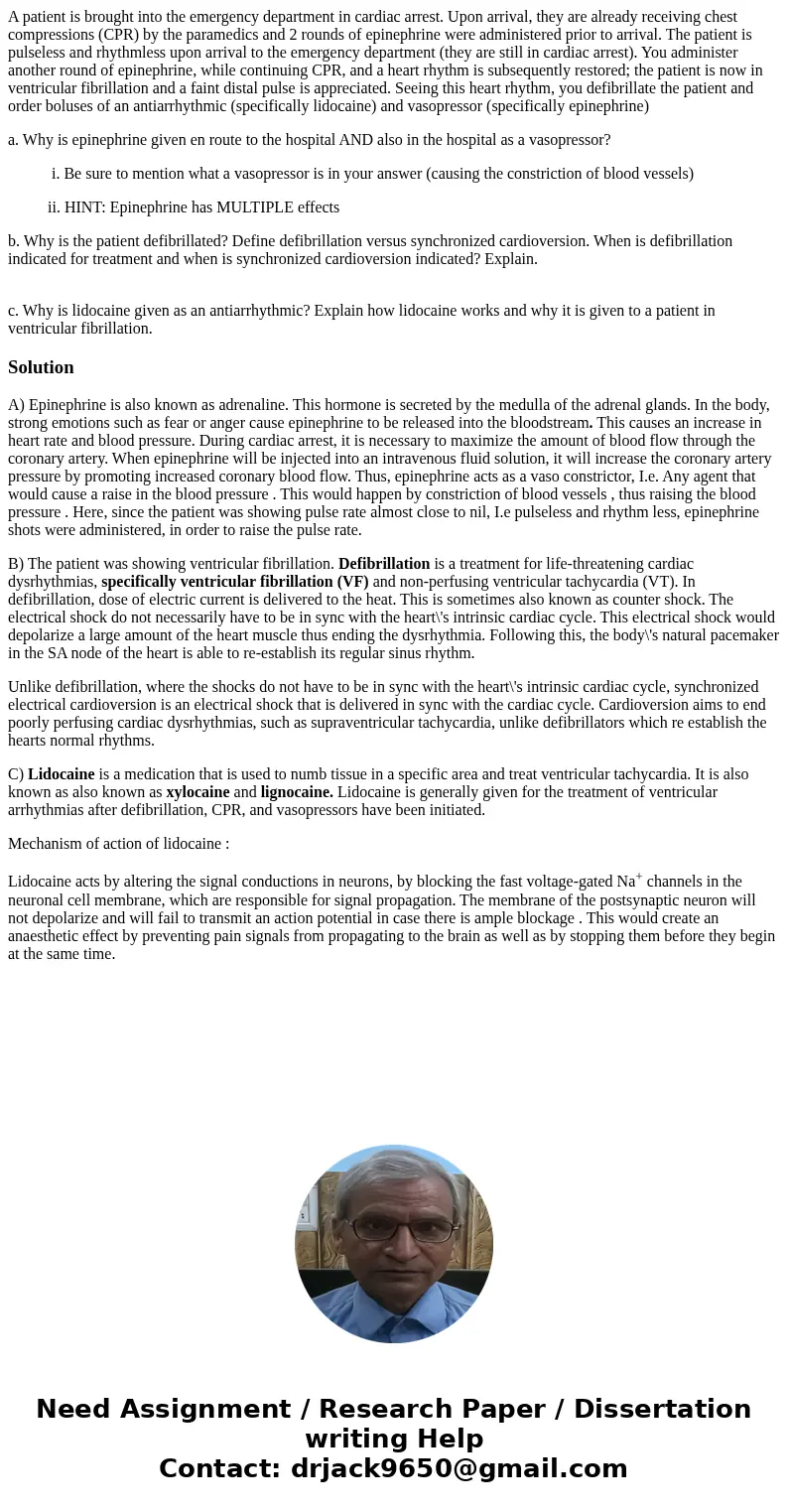A patient is brought into the emergency department in cardia
A patient is brought into the emergency department in cardiac arrest. Upon arrival, they are already receiving chest compressions (CPR) by the paramedics and 2 rounds of epinephrine were administered prior to arrival. The patient is pulseless and rhythmless upon arrival to the emergency department (they are still in cardiac arrest). You administer another round of epinephrine, while continuing CPR, and a heart rhythm is subsequently restored; the patient is now in ventricular fibrillation and a faint distal pulse is appreciated. Seeing this heart rhythm, you defibrillate the patient and order boluses of an antiarrhythmic (specifically lidocaine) and vasopressor (specifically epinephrine)
a. Why is epinephrine given en route to the hospital AND also in the hospital as a vasopressor?
i. Be sure to mention what a vasopressor is in your answer (causing the constriction of blood vessels)
ii. HINT: Epinephrine has MULTIPLE effects
b. Why is the patient defibrillated? Define defibrillation versus synchronized cardioversion. When is defibrillation indicated for treatment and when is synchronized cardioversion indicated? Explain.
c. Why is lidocaine given as an antiarrhythmic? Explain how lidocaine works and why it is given to a patient in ventricular fibrillation.
Solution
A) Epinephrine is also known as adrenaline. This hormone is secreted by the medulla of the adrenal glands. In the body, strong emotions such as fear or anger cause epinephrine to be released into the bloodstream. This causes an increase in heart rate and blood pressure. During cardiac arrest, it is necessary to maximize the amount of blood flow through the coronary artery. When epinephrine will be injected into an intravenous fluid solution, it will increase the coronary artery pressure by promoting increased coronary blood flow. Thus, epinephrine acts as a vaso constrictor, I.e. Any agent that would cause a raise in the blood pressure . This would happen by constriction of blood vessels , thus raising the blood pressure . Here, since the patient was showing pulse rate almost close to nil, I.e pulseless and rhythm less, epinephrine shots were administered, in order to raise the pulse rate.
B) The patient was showing ventricular fibrillation. Defibrillation is a treatment for life-threatening cardiac dysrhythmias, specifically ventricular fibrillation (VF) and non-perfusing ventricular tachycardia (VT). In defibrillation, dose of electric current is delivered to the heat. This is sometimes also known as counter shock. The electrical shock do not necessarily have to be in sync with the heart\'s intrinsic cardiac cycle. This electrical shock would depolarize a large amount of the heart muscle thus ending the dysrhythmia. Following this, the body\'s natural pacemaker in the SA node of the heart is able to re-establish its regular sinus rhythm.
Unlike defibrillation, where the shocks do not have to be in sync with the heart\'s intrinsic cardiac cycle, synchronized electrical cardioversion is an electrical shock that is delivered in sync with the cardiac cycle. Cardioversion aims to end poorly perfusing cardiac dysrhythmias, such as supraventricular tachycardia, unlike defibrillators which re establish the hearts normal rhythms.
C) Lidocaine is a medication that is used to numb tissue in a specific area and treat ventricular tachycardia. It is also known as also known as xylocaine and lignocaine. Lidocaine is generally given for the treatment of ventricular arrhythmias after defibrillation, CPR, and vasopressors have been initiated.
Mechanism of action of lidocaine :
Lidocaine acts by altering the signal conductions in neurons, by blocking the fast voltage-gated Na+ channels in the neuronal cell membrane, which are responsible for signal propagation. The membrane of the postsynaptic neuron will not depolarize and will fail to transmit an action potential in case there is ample blockage . This would create an anaesthetic effect by preventing pain signals from propagating to the brain as well as by stopping them before they begin at the same time.

 Homework Sourse
Homework Sourse